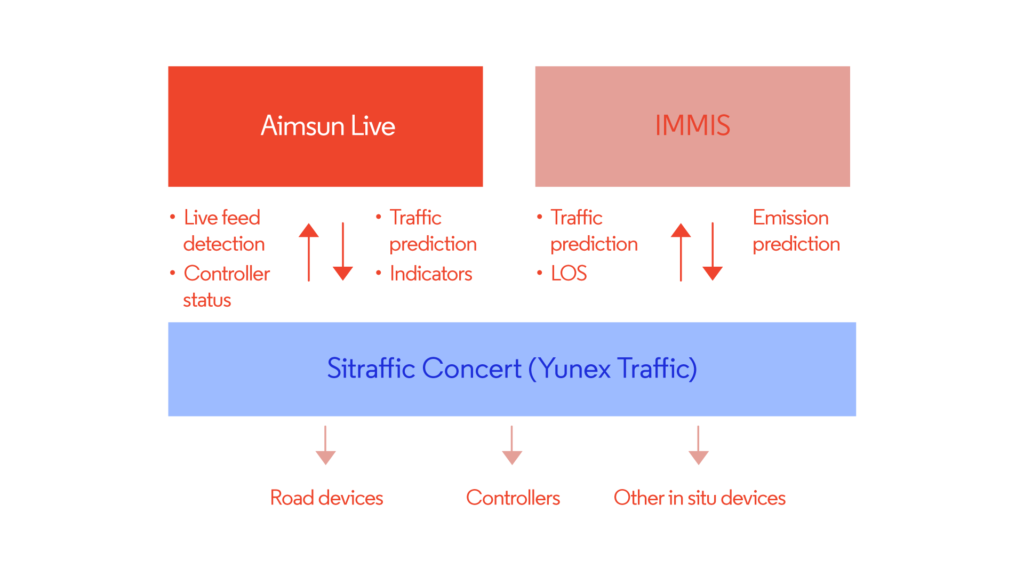
NEVFMA Network Emissions / Vehicle Flow Management
An Aimsun Live deployment in Oxfordshire, UK with integrated air dispersion modeling.
The City of Wiesbaden
Yunex Traffic
Wiesbaden, Germany
Start: 2019
Deployed: 2021
Currently under maintenance contract
Winner of the 2022 World Smart City Award for Mobility. Awarded at the Smart City Expo World Congress.
Hesse’s state capital of Wiesbaden has commissioned Siemens Mobility to implement its “Digitalization of Traffic” (DIGI-V) project, which is based on the city’s Green City Plan – Masterplan WI-Connect. Wiesbaden is lowering traffic-related nitrogen oxide emissions with an extensive air pollution control package covering all areas of mobility. To achieve this reduction in traffic-related emissions, extensive environmental and traffic data will be recorded, analyzed and processed in real time.
The system requires a large volume of data and information provided by cameras and sensors that quantitatively and anonymously monitor the traffic volumes of a variety of users such as vehicles, bicycles and pedestrians. Additional information covering public events, the city’s mass transit systems and the changing parking situation is also included in the system’s analysis, along with data provided by environmental sensors.
With the help of Big Data analytics, the flow of data from the various sources above can be processed and linked. Correlations can then be determined from the analysed environmental and traffic data, and appropriate measures can be identified. These real-time analyses are the basis for active, environment-sensitive traffic controls.
Three different systems will work together to achieve traffic and environment-oriented simulation-based forecasting:
The three products exchange data; the data required for simulation-based prediction are transmitted on a permanent cycle. This process takes place automatically without any user interaction.

In conjunction with Aimsun Live, Concert is able to simulate the impact of different traffic management scenarios that involve one or a combination of the following traffic management strategies:
The traffic control room operator can manually activate the traffic management strategies available for simulation with immediate effect for up to 3 different scenarios.
After completion of the simulation, the system presents the operator with a comparison of the simulated scenarios with key performance indicators (KPIs) in order to communicate their effectiveness and usefulness in system optimization. KPIs communicate traffic and environmental situations.
In addition to the KPIs, the simulation produces a traffic score based on the traffic KPIs and a formula. The higher the rating, the more suitable the scenario is for implementation from a traffic management point of view. This formula and the KPIs to be considered must be defined in order to reflect Wiesbaden’s traffic management needs. In addition, the simulation provides an environmental assessment based on IMMIS. The higher the rating, the more environmentally friendly the scenario is for implementation.


An Aimsun Live deployment in Oxfordshire, UK with integrated air dispersion modeling.

Satellite-generated atmospheric data helps local authorities devise real-time traffic management strategies for reducing pollution levels.
SHARE
Aimsun Next 23
Aimsun Next 20.0.5
Aimsun Next 23
@manual {AimsunManual,
title = {Aimsun Next 23 User's Manual},
author = {Aimsun},
edition = {Aimsun Next 23.0.0},
address = {Barcelona, Spain},
year = {2023. [Online]},
month = {Accessed on: Month, Day, Year},
url = {https://docs.aimsun.com/next/23.0.0/},
}
Aimsun Next 20.0.5
@manual {AimsunManual,
title = {Aimsun Next 20.0.5 User's Manual},
author = {Aimsun},
edition = {Aimsun Next 20.0.5},
address = {Barcelona, Spain},
year = {2021. [In software]},
month = {Accessed on: Month, Day, Year},
url = {qthelp://aimsun.com.aimsun.20.0/doc/UsersManual/Intro.html},
}
Aimsun Next 23
TY - COMP
T1 - Aimsun Next 23 User's Manual
A1 - Aimsun
ET - Aimsun Next Version 23.0.0
Y1 - 2023
Y2 - Accessed on: Month, Day, Year
CY - Barcelona, Spain
PB - Aimsun
UR - [In software]. Available: https://docs.aimsun.com/next/23.0.0/
Aimsun Next 20.0.5
TY - COMP
T1 - Aimsun Next 20.0.5 User's Manual
A1 - Aimsun
ET - Aimsun Next Version 20.0.5
Y1 - 2021
Y2 - Accessed on: Month, Day, Year
CY - Barcelona, Spain
PB - Aimsun
UR - [In software]. Available: qthelp://aimsun.com.aimsun.20.0/doc/UsersManual/Intro.html